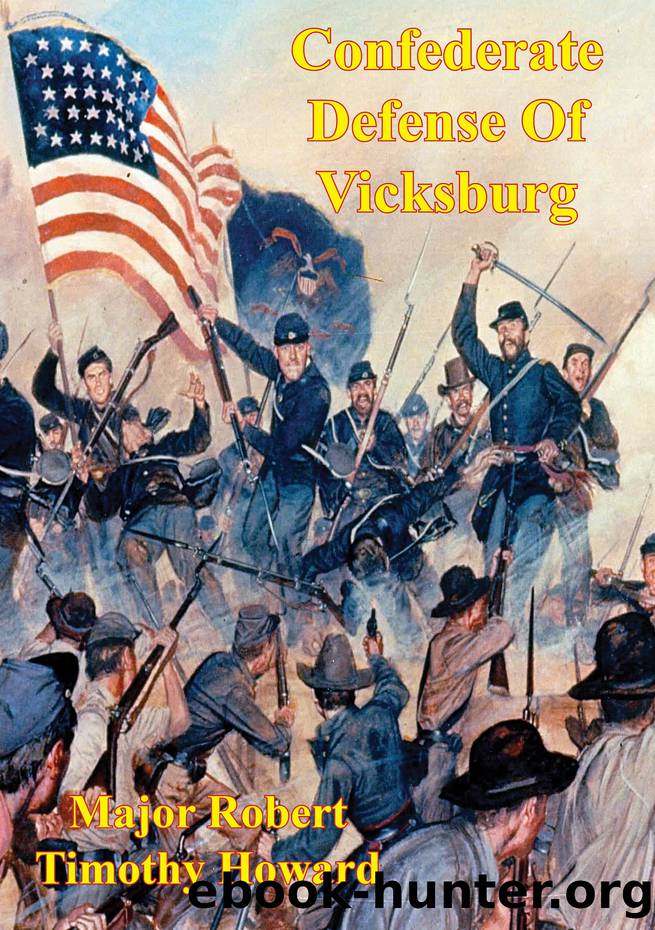Confederate Defense Of Vicksburg: A Case Study Of The Principle Of The Offensive In The Defense by Howard Major Robert Timothy;

Author:Howard, Major Robert Timothy;
Language: eng
Format: epub
Publisher: Golden Springs Publishing
Published: 2014-07-30T00:00:00+00:00
FIGURE 6 â BATTLE OF CHAMPION HILL{96}
Pembertonâs reply to Johnston outlined a plan to reverse the armyâs route of march, recross Bakers Creek, and return to Edwardâs Station. From there he planned to move up the Brownsville road toward General Johnstonâs position at Calhoun Station, seven miles south of Canton.
But the Confederate trains first had to he moved aside to make way for the front of the column which at that time was en the Raymond road heading east. Much confusion reigned as the elongated column of troops was reassembled and the wagons cleared out of the way. By 9: 30 the âroad was openâ and was âfree for the passage of troops.â{97} However, by the time his army was ready to move, Pemberton began to get concerned about the mounting din of battle to the southeast. It became evident that the Yankees were so close that they would soon be in a position to assault his long column and overrun the scattered units. Pemberton decided to forgo the move to join Johnston and ordered his division commanders to deploy in line of battle.
After some time, a battle line about one and one quarter miles long was formed extending north to south along the military crest of the ridge overlooking Jackson Creek. This ridge was just to the east of the Ratliff road. Loringâs division was on the right (south), Bowen in the center, and Stevenson on the left (north) (see Figure 6). The Confederates believed that this orientation would offer the best defensive line; they apparently were unaware that three Yankee divisions from McPhersonâs corps were advancing down the Jackson road (northern Union column) straight toward Pembertonâs vulnerable left flank.
About 9: 00 AM Brigadier General S, D. Lee, from Stevensonâs division, received a report from his forward elements that a strong Union column was approaching from the northeast.{98} This was startling news because there were no troops positioned to stop this advance and if this Union force continued unopposed, Edwardâs Station and the road to Vicksburg would be in Yankee hands.
Lee quickly shifted his brigade further to the north to block the Union advance. His brigade then occupied a narrow ridge with his right flank anchored on the crest of Champion Hill. Soon after Lee adjusted his position, Grant, in the Union camp, was made aware of the existence of a number of Confederate positions near Champion Hill.
In anticipation for an expected battle, Grantâs staff gave him a hurried briefing on the terrain in the vicinity of the ridgeline. Satisfied that the Hill could be taken, Grant decided to assault and directed two divisions, led by Brigadier General Charles E. Hovey and Major General John A. Logan to deploy in battle formation.
Lee watched these two divisions form in the fields to his front but noticed that the Yankee formations were oriented in such a way that his left flank was again threatened. Consequently, he again shifted some of his troops further to the left. This caused concern to the
Download
This site does not store any files on its server. We only index and link to content provided by other sites. Please contact the content providers to delete copyright contents if any and email us, we'll remove relevant links or contents immediately.
| United States | Abolition |
| Campaigns & Battlefields | Confederacy |
| Naval Operations | Regimental Histories |
| Women |
In Cold Blood by Truman Capote(3122)
Steve Jobs by Walter Isaacson(2735)
The Innovators: How a Group of Hackers, Geniuses, and Geeks Created the Digital Revolution by Walter Isaacson(2364)
All the President's Men by Carl Bernstein & Bob Woodward(2245)
Lonely Planet New York City by Lonely Planet(2088)
The Room Where It Happened by John Bolton;(2017)
And the Band Played On by Randy Shilts(1998)
The Murder of Marilyn Monroe by Jay Margolis(1962)
The Poisoner's Handbook by Deborah Blum(1956)
The Innovators by Walter Isaacson(1955)
Lincoln by David Herbert Donald(1854)
A Colony in a Nation by Chris Hayes(1784)
Under the Banner of Heaven: A Story of Violent Faith by Jon Krakauer(1664)
Amelia Earhart by Doris L. Rich(1572)
The Unsettlers by Mark Sundeen(1569)
Birdmen by Lawrence Goldstone(1525)
Dirt by Bill Buford(1503)
Zeitoun by Dave Eggers(1499)
Decision Points by George W. Bush(1449)
